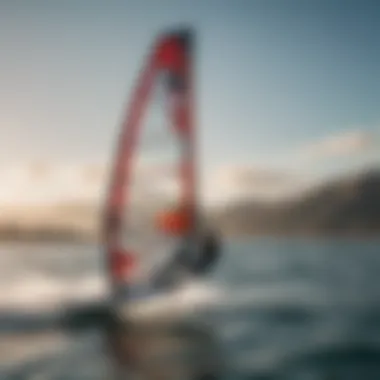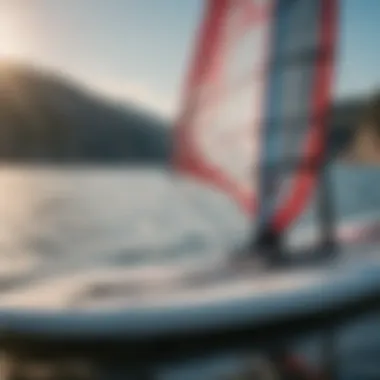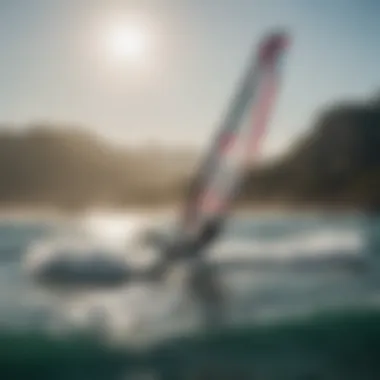Exploring Hydrofoil Windsurfing: Unveiling the Thrill


Intro
Hydrofoil windsurfing is an innovative progression in the water sports world, merging the classic essence of windsurfing with the unique dynamics of hydrofoiling. This sport provides a fresh perspective for both enthusiasts and newcomers, offering thrilling experiences that traditional windsurfing may not encompass. Understanding the mechanics, equipment, and techniques necessary for this discipline enhances user appreciation and safety. The popularity of hydrofoil windsurfing has surged, and this outline seeks to dissect its key elements.
Equipment Reviews
In hydrofoil windsurfing, equipment plays an essential part in optimizing performance and safety. Here, we take an in-depth look at the key components including hydrofoil boards, sails, and essential accessories for windsurfing.
Hydrofoils
Selecting the right foil is significant for achieving the desired performance. Different manufacturers produce foils designed for speed, maneuverability, or stability. It's essential to understand their specifications:
- Materials: Carbon offers a lightweight advantage, while aluminum is durable and cost-effective.
- Size: The aspect ratio primarily determines lift and control. Higher ratios suit smoother waters, while lower ratios enhance stability in rough conditions.
- Brands: Popular brands like RRD, Starboard, and Fanatic have diverse offerings in hydrofoil technology.
Boards
The board is another critical transition element in hydrofoil windsurfing. Various designs impact usability:
- Shape: Wider boards can provide more lift at slower speeds but may trading off sharp arcs when turning.
- Kinds: Freeride boards focus on speed and comfort. There are also specialized boards tailored for racing.
- Example Brands: JP Australia, Naish, and Gaastra showcase competitive models that push boundaries in windsurfing performance.
Sails
Sail selection impacts the control and performance of hydorfoil windsurfing:
- Material and Build: Mylar provides heightened rigidity, while more traditional materials enhance flexibility.
- Size: Sail size affects speed and responsiveness, mainly impacted by wind speed.
- Brands: North sails are known for their performance, alongside Duotone that optimizes for various skill levels.
Accessories
Having the right accessories ensures an enhanced riding experience. Important items include:
- Harnesses: These help distribute pull forces, allowing the rider to enjoy longer sessions without fatigue.
- Safety Gear: Helmets and impact vests offer necessary protection, especially during challenging maneuvers.
- Lines and Pumps: Ensure beach-ready settings with reliable pump action and suitably constructed lines to the rig setup without unnecessary tension or wear.
The choice of gear will greatly influence both performance and the enjoyment of hydrofoil windsurfing. Carefully select equipment that meets individual needs and fosters skill progression.
Understanding Hydrofoil Windsurfing
Hydrofoil windsurfing represents a cutting-edge development in the realm of water sports, marking a significant evolution from traditional windsurfing. This section elucidates the science and mechanics powers of this sport, crucial for anyone willing to begin or improve their skills. Understanding the methods and principles behind hydrofoil windsurfing greatly enhances an individual’s experience and enjoyment on the water.
Definition and Origin
Hydrofoil windsurfing involves using a foil attached to a board, which lifts the board above the water's surface as the wind fills the sail. This innovative approach not only allows surfers to attain high speeds but also provides a smoother ride, reducing the choppy surface effect found in conventional windsurfing. The origins of hydrofoil windsurfing date back to the early 20th century, where initial designs were experimented with in various vessel forms. The integration of winds and foils committees eventually led to the distinct branch of windsurfing practiced today. Understanding these origins explains how the sport became recognized and appreciated by enthusiasts worldwide.
How Hydrofoils Work
Hydrofoils function based on principles of hydrodynamics, which determine how objects interact with water during movement. The core of understanding how hydrofoils work involves two critical components of this framework: the Basic Principles of Foil Hydrodynamics and Lift Generation alongside Drag Reduction.
Basic Principles of Foil Hydrodynamics
The basic actions within foil hydrodynamics center around generating lift while disrupting drag. The key characteristic here is that a foil's shape helps create a pressure difference above and below the surface, allowing lift to indeed function. This unique design, especially in curved rather than flat forms, permits better fluid flow around it compared to conventional objects. This feature is mostly advantageous because it means surfers can ride on foils earlier and at lower speeds than traditional windsurf boards, enabling earlier take-off and a smooth riding experience.
Lift Generation and Drag Reduction
Lift generation in hydrofoiling is remarkable and significantly contributes to why this sport attracts such attention. Lift occurs when the water flows over a foil, creating an upward force that elevates the board. The beautiful interplay of speed and angle allows windsurfers to maneuver efficiently. Equally, reduced drag means that less resistive force acts against the board, leading to higher speeds with less energy exerted by the surfer. Understanding this aspect reveals not only the efficiency of hydrofoil board movement but embodies advantage athletes worldwide aspire.
The advancement in hydrofoil technology enhances the connection between rider and water, increasing efficiency and overall enjoyment.
In summary, desired refinement in hydrofoil design iteration is helping the sport expand comprehensively. Examining these focal areas will deepen the understanding essential for excelling in hydrofoil windsurfing.
Equipment Essentials for Hydrofoil Windsurfing


In hydrofoil windsurfing, the appropriate equipment plays a role of utmost importance. The right equipment not only enhances the experience but also significantly affects performance level. Various elements come into play here, including foil boards, sails, masts, and different foil components. Each distinct area holds significant weight in optimizing one's experience in this sport. A closer look reveals astonishing details that warrant thoughtfulness and careful choice by practitioners.
Foil Boards
Construction and Design Elements
When looking at foil boards, the construction and design elements are imperative for successful navigation and ride stability. These boards are crafted from materials like carbon fiber and epoxy, offering a lightweight yet sturdy build. This characteristic underlines performance by enabling a smooth experience on the water surface.
A major benefit of investing in a well-designed foil board is responsiveness during maneuvering. The dynamics of hydrofoil windsurfing hinges on how the board works with the foil. A unique feature is the use of adjustable foot straps, allowing personalized stance adjustments that aid both comfort and control while reducing fatigue. The right design hence contributes not purely to aesthetic appeal but profoundly affects operational efficiency.
Choosing the Right Board Size
Choosing the proper board size cannot be understated. Size avails not only affects buoyancy but also influences balance and stability. A larger board offers more surface area, which translates to easier lift. This can be helpful for beginners striving to achieve lift efficiently without excessive struggle.
On the other hand, opting for a smaller board provides maneuverability, thus attacting seasoned windsurfing enthusiasts searching for speed and agility. Several factors come into account, such as intended environment and personal skill level. Understanding these enhances decision-making processes for individuals new to the sport.
Sails and Masts
Importance of Sail Area
The sail area holds weight in shaping potential performance outcomes. A larger sail area permits harnessing more wind, thus amplifying speed. This becomes especially crucial in light wind conditions, where other boards might stagnate.
However, larger sail areas require enhanced skill for optimal maneuverability, particularly for beginners trying to tame unpredictable winds. These conflicting attributes present both possibilities and downfalls, making awareness central to performance.
Types of Masts for Hydrofoiling
Exploring various mast options can feel daunting, yet understanding each alternative is key to successful hydrofoiling. A typically relevant choice includes telescoping masts, they adjust to different heights which allow quick adaptations based on wind and rider preferences.
Another frequent option is the fixed mast, provides reliability. With simple design and durability, disadvantages include lack of options for quick alteration. Both types maintain specific relevance in hydrofoil usage and rider preferences.
Foil Components
Wings, Fuselages, and Masts
Focusing on foil components can yield useful insights into their contributions to your ride. Wings, for instance, are essential for generating lift and supporting stable navigation. The fuselage connects the sustaining wings and offers necessary strength and connection flexibly. Masts hold these components together, forming harmony in physical interactions with forces exerted by water and wind.
Familiarity with the unique performance characteristics of mast height, length, and wing design can bring tremendous transformation in your riding experience.
Material Considerations for Performance
The materials used in foil components are critical. Lightweight materials like carbon fiber are prevalent, mostly due to their shaer performance benefits. Selecting the right materials can reduce drag while increasing responsiveness. Sturdiness, however, is crucial too; low-quality materials may lead to decreased durability and potential breakdowns over time.
Furthering individual performance with intelligently chosen components enhances connection to both waves and winds. Exploring merits and demerits assists understanding for both novice and proficient athletes involved.
Effective attention to equipment enhances performance outcomes. The right setup assists existing expectations and confidence. Mastery of hydrofoil windsurfing becomes achievable not by accident but through informed choices.
Techniques in Hydrofoil Windsurfing
Techniques in hydrofoil windsurfing are vital for optimizing performance and enhancing safety on the water. Learning proper techniques enables the rider to master the unique dynamics of hydrofoil boards, helping in control and maneuverability. Essential techniques include launching and landing, achieving lift, as well as turning and maneuvering. Each of these aspects contributes significantly toward a positive hydrofoiling experience.
Launching and Landing
Launching involves transitioning from standing on solid ground to gliding across the water on a hydrofoil board. Especially for beginners, this step can be tricky. A proper launch technique ensures stability and minimizes the energy required to start riding. Landing requires careful consideration too, as controlled descent is essential to avoid hard impacts. Mastery of launching and landing can result in a more enjoyable time on the water, building confidence with each ride.
Achieving Lift
Achieving lift is key to hydrofoil windsurfing and involves getting the board out of the water using aerodynamic principles. This can be fascinating for both newcomers and experienced riders. Lift allows a person to glide above the water surface and decreases drag. It offers a uniquely smooth ride.
Timing and Body Positioning
Timing and body positioning are critical when trying to achieve lift. A rider must synchronize their movements with the wind and water conditions. Proper timing allows lift to be generated effectively, which directly affects the height above water. Body positioning involves leaning at the right angle to engage the hydrofoil. This results in balance and control, which in turn contributes to enhanced comfort and reduced risk of falls. Incorrect positioning can result in failure to lift off adequately or instability while riding.


Speed and Angle of Attack
Speed and angle of attack influence how effectively a rider can achieve lift. Speed must be sufficiently high to ensure that the hydrofoil generates lift. Without sufficient speed, the rider may struggle to lift off the water. The angle of attack pertains to how the foil interacts with the water. Adjusting this novice-friendly aspect helps in optimizing performance for every rider. Finding the right combination of speed and angle plays a crucial role in determining success in hydrofoil windsurfing efforts.
Turning and Maneuvering
Turning and maneuvering are essential to navigation and maintaining control while hydrofoiling. Each rider will navigate differently based on their environment and personal skill levels.
Downwind vs.
Upwind Turns
Understanding downwind and upwind turns is fundamental. Downwind turns are easier, requiring less effort and strategy compared to upwind turns. Riders can simply shift weight and adjust the sail to initiate the turn. Upwind turns demand more skill and may involve intricate body positioning and wind management. Effective transitions yield smoother rides and enhanced control over the board, helping riders adapt to varied conditions.
Managing Speed Through Turns
Managing speed is another critical consideration during turns. Experienced riders adjust speed while turning to maintain stability. Some techniques for lowering speed include easing the sail control and shifting weight forward. This action aligns the himself closely with the foil. Learning to comfortably reduce speed allows riders to execute a wide variety of turns without feeling overwhelmed. Grasping these subjects is pivotal in mastering hydrofoil windsurfing.
In summary, learning and mastering techniques in hydrofoil windsurfing increases the enjoyment, control, and safety of this thrilling sport. Each element presents others with unique challenges to intake, therefore cultivating a craft through knowledge awareness.
Advantages of Hydrofoil Windsurfing
Hydrofoil windsurfing presents a distinctive set of benefits that appeals to both seasoned practitioners and newcomers to the sport. Its advantages often stem from enhanced performance and seismic shifts in how techniques are employed compared to traditional windsurfing. By understanding these advantages, individuals can make more informed decisions about their involvement in this innovative water sport.
Enhanced Speed and Efficiency
One primary advantage of hydrofoil windsurfing is its potential for significantly improved speed. The hydrofoil is designed to lift the board above the water’s surface. This elevation minimizes drag caused by water flow, allowing for smoother rides. Riders often find that they can reach higher speeds than traditional boards, enabling thrilling experiences with less effort.
The combination of hydrofoil construction and effective sail techniques gives boards extraordinary glide capabilities. Riders can harness wind energy more effectively, resulting in longer rides without constant adjustments. Furthermore, the ability to travel faster is particularly useful when crossing waves and handling gusty conditions, often making for a more enjoyable experience on the water.
- Foiling allows riders to accelerate quickly.
- The reduced contact with the water results in reduced resistance.
- Painstaking positioning can lead to exceptional airtime.
In most conditions, riders report enjoying longer sessions as riding experience remains less physically taxing. This efficiency makes the sport more accessible to a greater range of athletes, regardless of skill level. Hence, mastering foiling techniques effectively translates to substantial performance gains.
Reduced Environmental Impact
Another, often overlooked benefit of hydrofoil windsurfing is its relatively low environmental impact. Traditional windsurfing visibility often involves more equipment entered in water. In comparison, foiling tends to require less energy from both wind and user effort.
The use of hydrofoil technology can lead to minimal disruption of marine life through reduced noise pollution and a lesser chance of getting stuck or snagging underwater flora. Users also appreciate shorter travel distances. Hence, hydrofoil windsurfing ultimately prompts growth with ecological considerations in mind.
Some aspects that highlight this environmental factor include:
- Less material use in equipment possibly reflecting in sustainable practices.
- Reduced consumption of fossil fuels when accessing water spots due to shorter trips by land.
- Potential for safer wildlife exchanges during natural appliances, allowing for tranquil interactions with natural elements.
Athletes and governments alike might become increasingly supportive of eco-friendly practices, ahead in integration with viewing emphases for future water sports developments. Overall, understanding these advantages in hydrofoil windsurfing provides essential insight into its growing reputation, fostering the sport for the new generation of water enthusiasts.
Discovered in the nuances of one environment, are possibilities enhancing aquatic performance with minimal ecological impact.
Learning about these critical aspects reveals important considerations for making hydrofoil windsurfing an appealing and responsible choice for water sports participants.
Challenges and Considerations
Hydrofoil windsurfing, while exciting, presents various challenges that practitioners should consider. Recognizing these obstacles is crucial for both beginners and seasoned windsurfers. A thoughtful approach to learning these nuances can greatly enhance one’s experience in the sport. Combining strategy with skill development can result in a fulfilling encounter with the water. These factors only highlight the complexity and richness of hydrofoil windsurfing as a sport.
Learning Curve for Beginners
For newcomers, the learning curve in hydrofoil windsurfing can be steep. It is essential to understand that it goes beyond traditional windsurfing. It demands a deeper understanding of both balance and coordination. Learners may find it challenging to lift off and fly above the water. Despite initial difficulties, developing these skills brings a rewarding sense of achievement. Like every sport, practice is significant. Having instructors or experienced practitioners guide beginners can facilitate skill acquisition.
Safety Concerns
Safety should always be a priority in hydrofoil windsurfing due to it’s physical and technical nature. Practitioners must acknowledge the inherent risks associated with this sport. When navigating those high-speed maneuvers close to water, understanding safety protocols is essential.


Equipment Familiarization
Familiarity with equipment is a vital safety consideration in hydrofoil windsurfing. This includes understanding how to rig sails correctly and manage the foil and board dynamics. Knowledge directly contributes to an enjoyable experience. Five surveyed windsurfers rated equipment familiarity as the number one factor relating to safety. Inappropriate handling can result in accidents or even gear loss. Therefore, practitioners should make it a priority to familiarize themselves.
Potential Risks and Precautions
Understanding potential risks in hydrofoil windsurfing aids in the reduction of injuries. Risks include collisions or falling due to miscalculations. On windy days, turbulent waters elevate risks further. A popular recommendation is to start in lighter wind conditions or calm waters, progressively taking on more challenging scenarios. Clearly defined precautions can reduce incidents significantly.
Always prioritize equpiment familiarization and understanding of conditions to ensure a safe experience in hydrofoil windsurfing.
Being part of the community helps too. From engaging on platforms like reddit.com or facebook.com, practitioners share insights and tips on current safety practices. Joining local talks or workshops strengthens beginners in mastering hydrofoil windsurfing properly. Connecting with guys that are more expert aids in better learning outcomes. Recognizing and addressing challenges in hydrofoil windsurfing leads to more adept practitioners, ensuring long-term engagement with this thrilling sport.
Community and Culture of Hydrofoil Windsurfing
Hydrofoil windsurfing is more than just a sporting activity; it represents a dynamic community that is growing globally. This culture is essential not only to those who participate but also to the new enthusiasts watching from the sidelines. Within this community, knowledge, skills, and experiences are freely shared, thus fostering a supportive environment.
The significance of this community manifests in several ways. First, it encourages beginners who might feel overwhelmed or intimidated by the sport. Seasoned riders often take time to mentor newcomers, mitigating the steep learning curve associated with hydrofoil techniques. Having such personal encouragement reduces fears and enhances enthusiasm within the sport.
In addition, shared experiences create bonds among participants. Whether it's learning a new technique or participating in competitions, each interaction reinforces the social aspect of hydrofoil windsurfing. Events and competitions create an atmosphere of camaraderie, where skills are put to the test and friendships are forged.
"A strong community transforms individual efforts into collective enjoyment and shared progress". Such sentiments are common among riders who thrill in not just personal achievements but in watching colleagues succeed.
Global Events and Competitions
Global events play a significant role in elevating the status of hydrofoil windsurfing. Competitions provide practitioners with a platform to showcase their skills and innovations. Major events often attract participants from various continents, reflecting the sport's rapidly growing appeal. They further enhance visibility, drawing in sponsorships and media attention that helps validate the sport on larger platforms.
Events are often structured by categories, allowing both newcomers and elite competitors to compete. Some popular competitions include:
- International Hydrofoil Championships: Showcase the best talent worldwide.
- Red Bull Foiling Generation: Develops youth abilities through mentorship and equipment access.
Pointing out these events cultivates excitement around hydrofoil windsurfing, acting as a catalyst for attracting fresh talent and establishing new partnerships within the industry.
Online Forums and Groups
The digital age has propelled interest in hydrofoil windsurfing through online platforms. Forums and social media groups serve as vital resources for riders of all skill levels. Sites like Reddit, Facebook, and specialized websites form virtual communities where enthusiasts can connect. They exchange tips, trade equipment advice, or share vivid experiences from their latest sessions on the water.
Among the most prominent online destinations are:
- Facebook Groups Enhanced by Geolocation Features: Allows members to share relevant local information and coordinate meet-ups.
- Reddit Pages Dedicated to Hydrofoil Discussions: Dive into focused threads addressing everything from gear recommendations to troubleshooting technique.
This online interaction is crucial, especially in keeping the exploratory spirit of hydrofoil windsurfing flourishing. Opportunities for engagement keep enthusiasts motivated, instilling a sense of belonging and growth within the culture.
By immersing oneself in the community, both in-person and online, one gains not only skills but also friendships that deepen the enjoyment and longevity of participating in hydrofoil windsurfing.
The Future of Hydrofoil Windsurfing
The trajectory of hydrofoil windsurfing is deeply influenced by innovations and shifting engagement levels among enthusiasts and newcomers alike. As advancements in technology reshape how these water sports are experienced, hydrofoil windsurfing finds itself at the cutting edge of both performance and accessibility. This realm of water sports is poised for growth, due in part to the myriad benefits that hydrofoil boards provide, surpassing those of traditional setups.
Technological Advancements
In the realm of hydrodynamics, technology is constantly evolving. Modern hydrofoils are streamlined incessantly. These changes greatly affect performance and usability. Lightweight and durable materials like carbon fiber are now common in hydrofoil construction. This transformation allows users to experience not just faster speeds but also enhanced stability while riding.
Electric-powered foils are emerging, opening doors for different types of users. These craft are equipped with battery systems that allow hydrofoiling without the need for conventional wind. This significant shift enables options for hydrofoil windsurfing in various wind conditions, expanding its global appeal to those who may find traditional setups daunting. With exciting innovations within sail design, manufactures reckon that sails can generate better lifts and perform efficiently at different angles over water.
As hardware improves, the software aspect of hydrofoil windsurfing is also in flux. Innovative apps and shared platforms will continue to support data gathering about conditions, techniques, and community learning experiences. The introduction of virtual reality training tools is expected to significantly aid novices in mastering skills faster. These innovations pool collective knowledge and practice into comprehensible formats that support burgeoning talents, minimizing the classic learning curve many face.
Growth in Popularity
Hydrofoil windsurfing has gained traction in various international locations. An increase in club memberships and participation rates points toward a broader interest from a more diverse audience. Hydrofoil kits remain a popular addition at rental outlets along coastlines, enhancing opportunities for people to give it a go before committing to full purchases.
On social media platforms like Facebook and forums like Reddit, individuals share videos, discussions, and insights about their experiences. These spaces nurture a thriving online presence, where newfound enthusiasts connect with established riders. Community engagement increases awareness of fun opportunities, notably traveling to competitions.
Exciting international competitions contribute to the ascent of hydrofoil windsurfing. Champions are celebrated and rapidly build cool branding, prompting relevancy to wider audiences. It further allows emerging manufacturers, such as Fanatic and Naish, to attract customers interested in performance products suited for their skill levels. This developing culture defines the growing narratives in this sport. Those narratives, circulated online, spark intrigue about hydrofoil windsurfing and create ripple effects that lead many to inquire and participate.
"Hydrofoil windsurfing represents a unique frontier in water sports, combining newer technologies with the captivating experience of manipulating wind and water."
In summary, the future of hydrofoil windsurfing illustrates not just an evolution of equipment but a reinvigorated passion for water sports. The impact of technological growth, alongside increasing popularity, suggests an expansive horizon. With ongoing advancements coupled with enthusiasm among new users, hydrofoil windsurfing is set to redefine the limits of aquatic exploration.







